Nia… in Latin, neea buxifolia. In English, saltwood.
This tree should be used more outside of Puerto Rico and Florida.
Why?
This is why:

My friends, this is Mr. Mike Sullivan’s spectacular Nia specimen. It has won many awards; at Kawa Bonsai Society’s annual show, at the Bonsai Societies of Florida 2012 convention, to the last National show in Rochester New York (where it got best Tropical. It should have gotten best in show). It’s awesomeness is all in the details. The bark is old and craggy, the branches are refined and even in the interior, where you can’t see (unless you steal a peek like I did), is in scale and detailed.
Be you tea full!
Nia is native to Puerto Rico , St Thomas and St. John (US Virgin Islands) and Virgin Gorda (British Virgin Islands).
Some people use it for hedges but it’s not really used commercially. My Puerto Rican friends tell me it’s just a weed.
It will grow in moderate shade and can tolerate rocky soils.
It is more prevalent in the north of the Puerto Rican island in the moist limestone hills.
They should be easy to collect as there is no tap root but long lateral roots. The wood is so finely grained that they don’t have visible growth rings. They are slow growing. A tree in the shade will grow only a few inches a year. A tree in the open will get to be about 6 ft tall in eight years.
They tend to grow like broomsticks and telephone poles, with no taper.
Therefore, most bonsai you see will have a trunk chop like this

Unfortunately, the nia won’t heal a wound that size. Or any wound of any size it seems (except superficial ones).
Which is odd because they will emit buds from almost anywhere. They are so dense and twiggy its easy to just let them grow like a topiary. I hope this post will steer you away from that.
Let’s begin:
Subject A-

Nice shape and good trunk. This is an old tree from Jim Smith now belonging to my friend Dave Velez.
Its just a little bit “shrub-like”.
Let’s open it up let the birds fly through the branches.

First branch trimmed. I’ll have to add some wire and readjust the branches to fill in some spaces that I cut out.

Looking a bit ragged. It’ll turn out well. Promise Dave.

I exposed that wound on purpose. My plan is to carve it to give the cut a natural look to it.
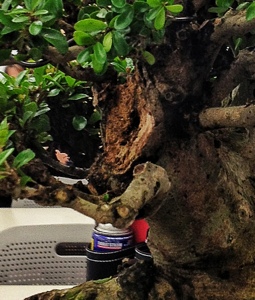
And also to lighten it up and make the details fit the scale of the tree.
I just have the right,top side to trim now.

You can see the density of the foliage.

There it is. We had just repotted it and I may need to readjust the front a little. We’ll let it grow a bit and see.

And after. Just needs that detail carving. And it will be a show tree soon.
The next Nia I got from Hector Morales.
For the first couple of years I had it, I just topiary trimmed it. This year I let it grow and in April I did my first real work on it.

I spent maybe an hour pruning it, wiring it and cleaning it up. I even attached a guy-wire to bring a heavy branch down.

I think I tamed it well.
I’ve let it grow and trimmed the wild shoots, removed some wire and here it is in August.

It’s filled in nicely.
I retrimmed it and repotted it into this blue glazed pot. The tree really needs an oval but I didn’t have one at the time.

I may or may not keep the first right hand branch. It doesn’t hurt it at the moment and it adds to the design. It creates negative space and brings the height down a bit.
The rear is filling in well. And I’m pleased with the way the front is filling in.
The next step (the same as Dave’s Nia) will be some carving.

This trunk chop has to be addressed and there are some other wounds that could be incorporated and unified with the design.

I need to work on the taper from the trunk to the leader. My son says it looks like one tree was planted on top of another tree. And he’s right.

There’s nothing I can do about this skinniness. It is indicative of the growth habit of the Nia as you’ll see with the next trees.

This little Nia has a long way to go but it will be cool. When I first got it the branches were all growing straight up. Wiring and pruning has given me some horizontals. I will carve the top jin next year.

You can see how flat this one is too.

Good back branching.
The way to develop a Nia is easy. It just takes time (as with all bonsai).
Let it grow. Style it. Let it grow. Prune it. Let it grow. Cut it back. Let it grow. Rewire it. Let it…… You get the idea.
Letting your tree grow is the most important step in any bonsai. I know you feel guilty when you look at it and see all that unkempt foliage but….let it grow. You will develop the tree faster and it will be more healthy. Promise.
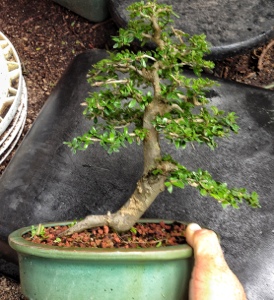
And then I trimmed it.
This one has a defect that is common with nursery grown Nias.
(All the previous ones were collected in Puerto Rico.) This one was either a cutting or a seedling from Jim Smith’s nursery.

There is little nebari on this tree on the right side.
Adds a bit of rock (coquina actually) and it creates a visual mass that fills that hole.
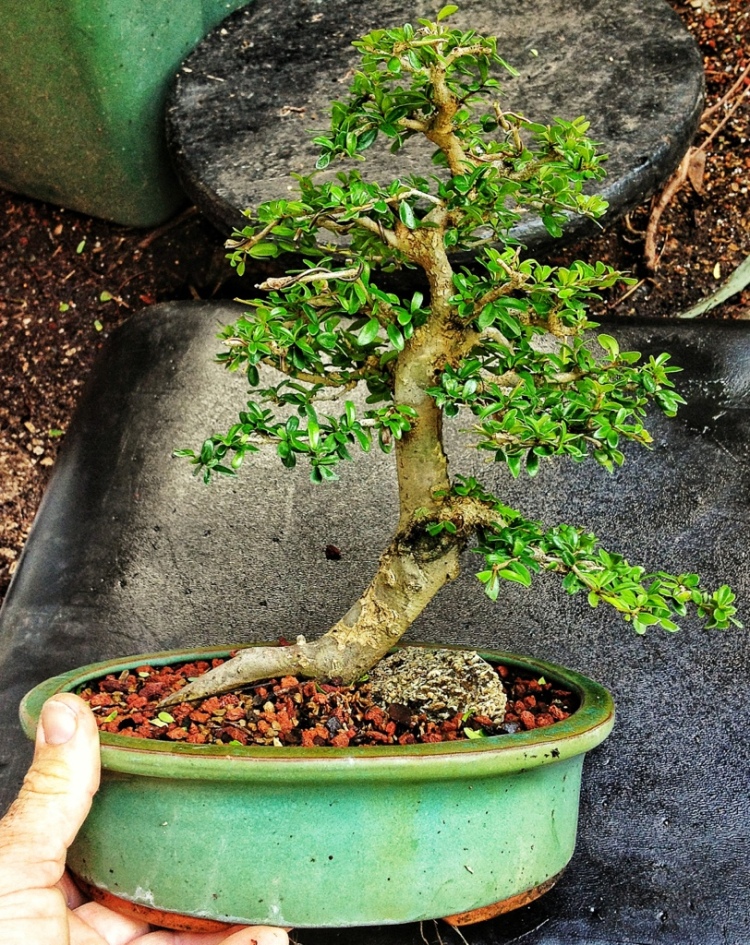
This last tree was one I got from Hector Morales as well. It’s unique in that it seems to have been split down the middle.
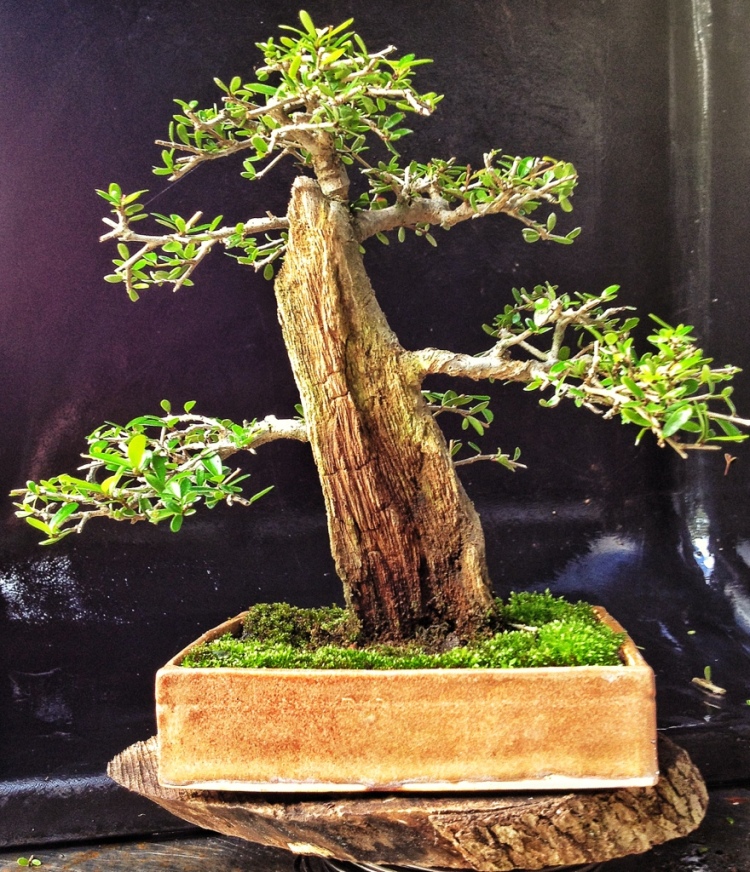
This is the front. The entire front is deadwood.

It’s old wood too, with fissures and cracks. I maintain it by cleaning it with a wire brush.

The side view shows the profile and how the tree seems to be a half of a trunk. Split in twain, even.
It was this feature that drew me to it.
It’s in a “topiary” phase right now and needs some more rear branching.
This tree will be fun:

But not yet. That one will be next year.I got it from Mike Cartrett in a trade.
I’ll post updates as needed.

Probably not until next year though.
The Nia is a true tropical. Don’t expose it to temperatures below 34 Fahrenheit or 1-3 Celsius. It also needs lots of light.
In the winter, if it stays indoors too long in low light, all the leaves will turn black and fall off. Won’t kill it but it’s disheartening.
The leaves won’t grow back until spring.
Other than that, it’s a hell of a plant for Bonsai. Go find yourself one.

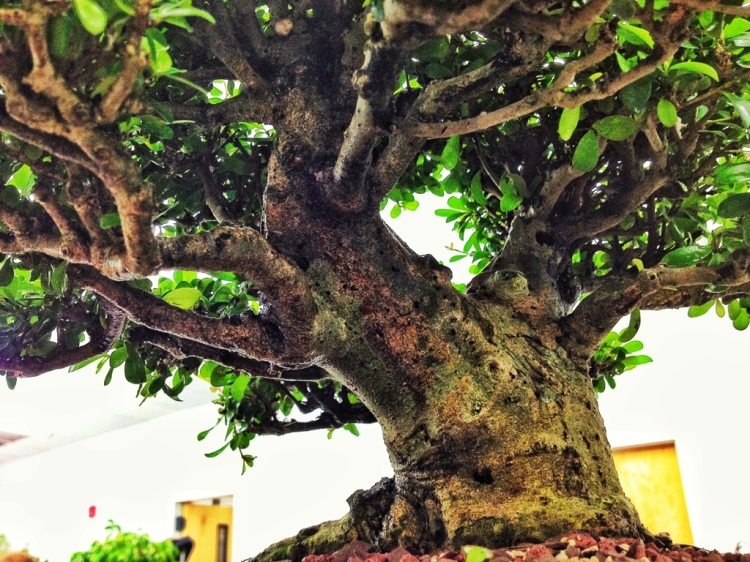
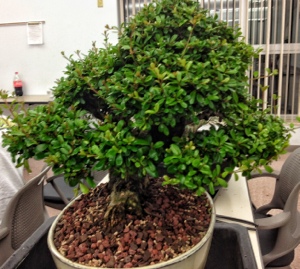




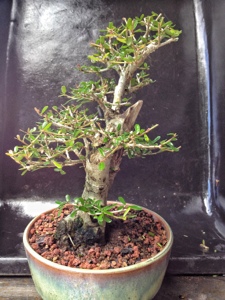


You just may influence an opinion change about nias for me. The white backdrop makes trees pop more, imo.
LikeLike
I’m trying.
. I like both color backdrops for two different reasons. The black is good for the artsy shots. The white for clinical shots. I vacillate between the two
LikeLike
Thanks for all the pics. and info about “Nia”
I got one at an orchid show not knowing a thing about how to or the plant itself…
A weed??? Ha Fooled me. 😎
Guess it was a good find. Wish me luck
LikeLike
Thanks for reading!
Good luck
LikeLike
Thanks for all the pictures and info, I’ve got one neea in san Juan many years algo. Since then it has been growing wild.
As in my country, Venezuela, one can’t find that beautiful plant, I would like to reproduce it from twigs for my bonsaist friends.
So far I have been unable to do it.
What would you recomend me?
Thanks for your time!
LikeLike
Hi Clariana,
It is a terribly hard plant to propagate. My only tip is to make sure the water you use is clean, not well water, but a municipal source or bottled.
Hope that helps, I know it’s not much to go on.
LikeLike
HI Adam. I hope you are well. Great info on Neea’s. I noticed that you did not defoliate any of the trees. Is it okay to defoliate when repotting?
LikeLike
It is ok. But all those tiny leaves?!
If the tree is stress it’ll drop them anyway but it is becoming mite evident through trials and studies done by the university extension offices that when transplanting a tree or plant keeping leaves on help the tree grow new roots faster.
LikeLike